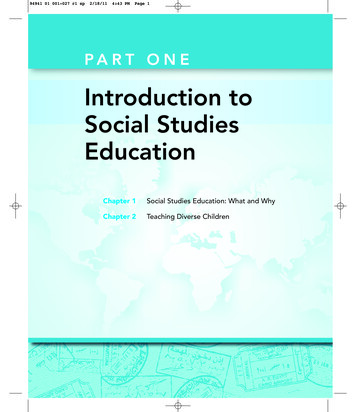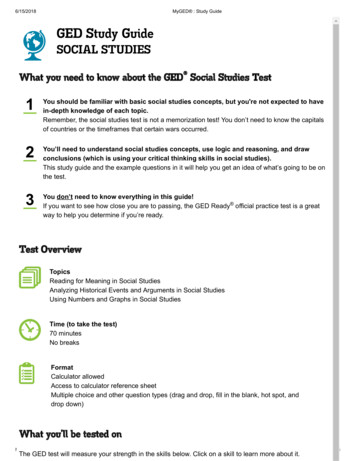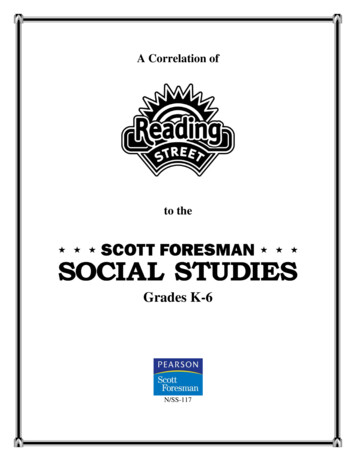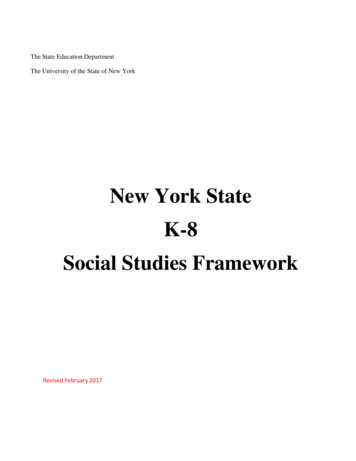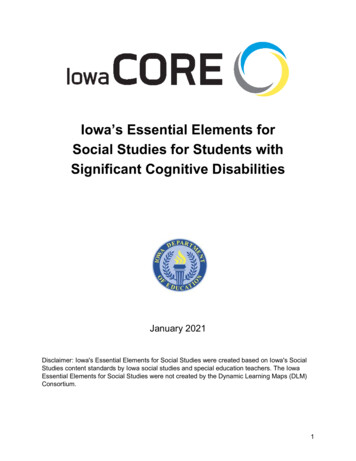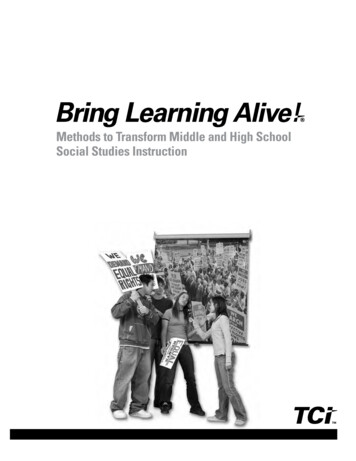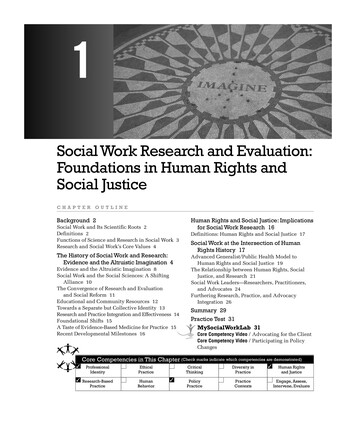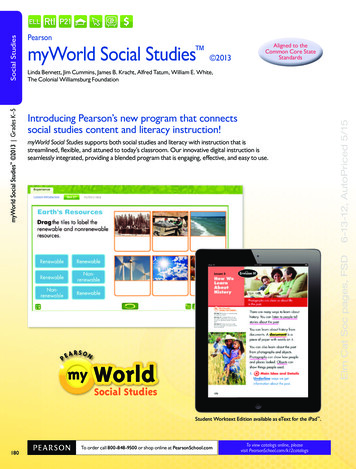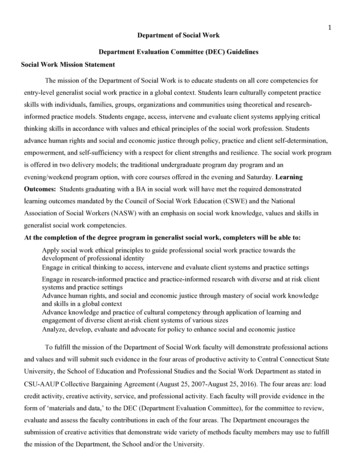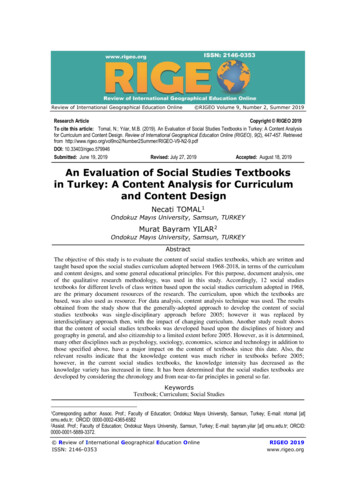
Transcription
Review of International Geographical Education Online RIGEO Volume 9, Number 2, Summer 2019Research ArticleCopyright RIGEO 2019To cite this article: Tomal, N.; Yılar, M.B. (2019). An Evaluation of Social Studies Textbooks in Turkey: A Content Analysisfor Curriculum and Content Design. Review of International Geographical Education Online (RIGEO), 9(2), 447-457. Retrievedfrom 9-N2-9.pdfDOI: 10.33403/rigeo.579946Submitted: June 19, 2019Revised: July 27, 2019Accepted: August 18, 2019An Evaluation of Social Studies Textbooksin Turkey: A Content Analysis for Curriculumand Content DesignNecati TOMAL1Ondokuz Mayıs University, Samsun, TURKEYMurat Bayram YILAR2Ondokuz Mayıs University, Samsun, TURKEYAbstractThe objective of this study is to evaluate the content of social studies textbooks, which are written andtaught based upon the social studies curriculum adopted between 1968-2018, in terms of the curriculumand content designs, and some general educational principles. For this purpose, document analysis, oneof the qualitative research methodology, was used in this study. Accordingly, 12 social studiestextbooks for different levels of class written based upon the social studies curriculum adopted in 1968,are the primary document resources of the research. The curriculum, upon which the textbooks arebased, was also used as resource. For data analysis, content analysis technique was used. The resultsobtained from the study show that the generally-adopted approach to develop the content of socialstudies textbooks was single-disciplinary approach before 2005; however it was replaced byinterdisciplinary approach then, with the impact of changing curriculum. Another study result showsthat the content of social studies textbooks was developed based upon the disciplines of history andgeography in general, and also citizenship to a limited extent before 2005. However, as it is determined,many other disciplines such as psychology, sociology, economics, science and technology in addition tothose specified above, have a major impact on the content of textbooks since this date. Also, therelevant results indicate that the knowledge content was much richer in textbooks before 2005;however, in the current social studies textbooks, the knowledge intensity has decreased as theknowledge variety has increased in time. It has been determined that the social studies textbooks aredeveloped by considering the chronology and from near-to-far principles in general so far.KeywordsTextbook; Curriculum; Social Studies1Correspondingauthor: Assoc. Prof.; Faculty of Education; Ondokuz Mayıs University, Samsun, Turkey; E-mail: ntomal [at]omu.edu.tr; ORCID: 0000-0002-4365-65822Assist. Prof.; Faculty of Education; Ondokuz Mayıs University, Samsun, Turkey; E-mail: bayram.yilar [at] omu.edu.tr; ORCID:0000-0001-5889-3372. Review of International Geographical Education OnlineISSN: 2146-0353RIGEO 2019www.rigeo.org
Review of International Geographical Education Online RIGEO, 9 (2), Summer 2019For better comprehension of the subject, information on the period from theintroduction of social studies class into the Turkish elementary and secondary schoolcurricula and the social studies textbooks as a teaching material.Theoratical FrameworkDevelopment of Social Studies Education in TurkeySocial studies have been taught as a compulsory course in Turkish elementaryschools since 1968, and also in secondary schools since 1975 despite someinterruptions time to time (Ambarlı, 2010, p. 20).Developed based upon the relevant curriculum, the textbooks are the mostimportant materials of educational activities provided for students and teachers.These materials help students reach the information and help teachers develop theeducation process. As with the textbooks of other disciplines, social studiestextbooks have been considerably changed in time in parallel with the changes in thecurriculum. When reviewing the literature, it has been realized that a good number ofstudies was carried out on social studies textbooks from past to present. There aremany studies that have been carried out especially on social studies textbooksrenewed depending on the curriculum change in 2005. It is seen that there are agrowing number of studies on the social studies textbooks used in Turkey since 2005school year, and that the majority of the opinions on the textbooks from the saidperiod has become mostly positive. However, some of these studies highlight issueswith the social studies textbooks in terms of content. In this study, the positive andnegative aspects of textbooks written both before and after 2005 were evaluated interms of their contents.MethodologyResearch DesignA qualitative approach was adopted, and document analysis, which is a qualitativedata collecting technique, was used in this study. Document analysis is a method thatconsists of some systematic steps intended for reviewing or evaluating of printed andelectronic documents (Bowen, 2009, p. 27).The document sources of the study consist of 12 social studies textbooks used onthe 4th, 5th, 6th and 7th grade levels between 1968 and 2018. To be able toaccurately evaluate the content of social studies textbooks from 1968 to the presentday, the textbooks from different grade levels and with contents specifically based onthe curricula that were effective in different periods.The social studies textbooks taught between 1968 and 2018 were used as the maindata source in content evaluation for the study. The textbooks subject to documentanalysis in this study, are given in the Table 1:448
Review of International Geographical Education Online RIGEO, 9 (2), Summer 2019Table 1Data on Textbooks Used as Data Resource in the StudyWriter nameYearTextbooknameRakım Çalapala1978aSocial Studies(Elementary:4)Rakım Çalapala1978bSocial Studies(Elementary:5)Niyazi Akşit, Ferruh Sanırand Tarık Asal1979Güler Şenünver, EzdiharKarabulut, H. SamimKesim, Rıfat Turgut,Nesibe Ercan, MustafaKüçükbaycan, HasanHuslu and Aliye AkiyeGüler Şenünver, EzdiharKarabulut, H. SamimKesim, Rıfat Turgut,Nesibe Ercan, MustafaKüçükbaycan, HasanHuslu and Aliye AkiyeDemet Karagöz, MeltemTekerek, Niyazi Kaya,Hikmet Azer, Melek DeryaAlıç, Bekir Yılbat, MiyaseKoyuncu, Kadir UlusoyEmine Genç, Mecit MüminPolat, Samettin Başol,Niyazi Kaya, Hikmet Azer,Sevil Gökçe, MiyaseKoyuncu, Abdul CelilGök, Abdullah Yıldız,Dilek Yılmaz, ÂdemÖzcanMurat Gürkan Gülcan,Özen Bayram, Zafer Kılıç,Fatih. M. Karakaya, AliyeMidilliÖmer Faruk Evirgen,1999Social Studiefor SecondarySchools 2ElementarySchool SocialStudies 7Publisherİnkılap and AkaPublishingHousesİnkılap and AkaPublishingHousesNationalEducation PressNationalEducation Press2001ElementarySchool SocialStudies 7NationalEducation Press2008ElementarySocial Studies5Ministry l Studies6Ministry ofNationalEducationPublications2010Elementary5th GradeSocial StudiesTextbookSocial StudiesKoza Publishing& Distribution2017449Ministry of
Review of International Geographical Education OnlineJulide Özkan, SunaÖztürk, Zuhal ÖzduralTextbook 5Erhan Şahin2018Faruk Gökalp Yılmaz,Hasan Bayraktar, MustafaKemal Özden, MuratAkpınar, Ömer EvinGökhan Gültekin, MuratAkpınar, Mustafa Nohutcu,Pınar Özerdoğan, SeherAygün2018Social StudiesTextbook 5Social StudiesTextbook 62018Social StudiesTextbook 7 RIGEO, 9 (2), Summer ıkMinistry ofNationalEducationPublicationsMinistry ofNationalEducationPublicationsAs part of the study, the general evaluation of the contents of social studies textbooksreferred to the textbooks given in Table 1, as well as various publications examiningsocial studies education curricula and textbooks of 1968, 1998, 2005 and 2018 in termsof content (Nas, 2000; Demirel, 2010; 2012; Baykara, 2012).Content analysis technique was utilized in the analysis of the data obtained from thestudy. Content analysis, which is a widely used qualitative research method, is one ofthe research methods in which text data is analyzed based on the content or contextualmeaning of the text (Hsieh & Shannon, 2005, p. 1277-1278). The process of contentanalysis involves bringing together similar data on the basis of certain concepts andthemes and interpreting them in a way that is comprehensible for the reader (Yıldırımand Şimşek, 2013, p. 259). This study only covered the themes out of the code, categoryand theme trio that is frequently created in content analysis, and the contents of socialstudies textbooks were evaluated under these themes according to their prominentfeatures, as well as common and distinct points. In order to improve the reliability of thestudy, the obtained data were discussed periodically with the domain experts, and thedocuments were revised where differences had been detected.FindingsThe content analysis carried out for the study revealed significant changes in thecontent of the textbooks throughout the period spanning the years when the socialstudies course was introduced to the primary and secondary school curricula up to thepresent day. This section aims to analyze said changes in the content of social studiestextbooks under 2 main headings, which are curriculum development and content designtheme and general teaching principles theme.Evaluation of Content in terms of Curriculum Development and ContentDesignsAccording to the study, social studies curriculum comprising of subjects that are inrelation to each other such as history, geography, sociology, etc. is enough for thiscurriculum to be considered a curriculum with extensive design. There is no need to450
Review of International Geographical Education Online RIGEO, 9 (2), Summer 2019blend together information from different fields in a learning domain. After all, asagreed by some researchers, extensive design should be considered alongsideinterdisciplinary design, and therefore, content from various areas should be integratedin a textbook based on extensive design. Otherwise, the textbooks used prior to 2005,which usually included information on each field under individual units except for thoseregarding citizenship knowledge, or in other words, which were based on the sense ofsingle discipline where history, geography and citizenship knowledge textbooks arecombined into a singe textbook, can be considered extensive design textbooks only inname. Rather than such content systematic, it may be more convenient to have separatecourses such as history and geography that constitute the social studies course. Thecurrent social studies textbooks, on the other hand, seek to combine information fromdifferent fields in a learning domain. In other words, existing social studies textbookscan be considered in the context of extensive design both in name and practice, based oninterdisciplinary design.The previous chapters of the study have mentioned how current and previous socialstudies textbooks emphasize general teaching principles such as from near-to-far andchronology. Based on these explanations, it can be said that linear content approach hasbeen utilized in social studies curriculum and textbooks. Also, with the increase indetail, the repetition-oriented spiral approach has been utilized in content creation forsocial studies textbooks from past to date.Evaluation of Content in Terms of General Teaching PrinciplesEvaluation of content in terms of integrity principle. As stated in theintroduction part of the study, social studies was introduced as a course for the first timein primary schools in 1968 and in secondary schools in 1975. When social studies wasintroduced as a course in primary schools in 1968, the textbook had not been preparedyet, and this continued until 1975. One of the supplementary textbooks used in the early1970s until the textbooks were prepared was the social studies textbooks by Çalapala(Alaca, 2017, p. 762). As can be seen in these examples on the content systematic of thesocial studies textbooks from previous years, it is thought that it may prove confusingfor students if subjects that are continuations of one another are interrupted for othersubjects and resumed later. Therefore, based on these explanations, one can talk aboutan issue of content complexity or a disorganized content systematic here. Despite thisunfavorable aspect, the primary concern behind the fact that history andgeographysubjects are featured together and taught alternately or a unit is entirelycomprised of geographysubjects and the next one is comprised of historysubjects insocial studies textbooks might have been to avoid boredom among students.Each learning domain is internally coherent in terms of content; it does not havesignificant direct relation with the preceding or following learning domains. That is tosay, the social studies textbooks that are currently being taught are largely comprised ofindependent learning domains. As a matter of fact, these textbooks were prepared withthe intention of achieving internal coherence within each learning domain.451
Review of International Geographical Education Online RIGEO, 9 (2), Summer 2019Evaluating the content in terms of chronology and from near-to-farprinciples. An examination of the order of history and geography subjects taught insuccessive grades is necessary to be able to make an evaluation about whether theprevious and current social studies textbooks take the chronology principle, which iscrucial in the teaching of history subjects, or from near-to-far principle, which isrequired for geography teaching, into consideration. In this context, in addition to the1978 edition of the 5th grade textbook, for which have provided examples above aboutits content, the 4th grade textbook was also analyzed in terms of chronology and fromnear-to-far principles.The contents of the social studies textbooks published prior to 2005 were preparedaccording to the order from the past to the present day, thus they clearly takechronology into consideration. The order of history subjects in the current social studiestextbooks and ones prepared according to the 2005 curriculum is largely the same asthat of the previous textbooks. The only difference with the previous social studiestextbooks is that, in the social studies textbooks prepared after 2005, the subject ofancient civilizations precedes the first Turkish states (Genç, Polat, Başol, S., et al.,2008).In the 1978 edition of 4th and 5th grade social studies textbook, geography subjectsare listed as follows: The order of the 4th grade textbook follows the subjects 'ourprovince' (the province where the student resides is thoroughly introduced), 'Turkey'sgeographic regions', 'the geography of Turkey', respectively, while the order of the 5thgrade geography follows the subjects 'latitude and longitude', 'the position of Turkey','Turkey's neighbors', 'the Earth's movements', 'the formation of the seasons and daynight cycle', 'major countries of the world'. (Çalapala, 1978a). Therefore, it can be saidthat, throughout the period until 1997, the contents of social studies textbooks wereprepared based on from near-to-far principle. As with all other textbooks publishedbefore 2005, the 1997 edition of 4th grade social studies textbook likewise appears toemphasize the introduction of all aspects of the province where the student resides (Nas,2000, p. 502-503). However, when it comes to other geography subjects, no connectionis established between each subject and the immediate environment unlike the socialstudies textbooks of today. For example; the 2001 edition of the 6th grade textbook onlyfocuses on Turkey in general on the subject of 'agriculture in Turkey', while failing todraw attention to the agricultural activities in the region where the student resides(Şenünver et al., 2001, p. 117). The current social studies textbooks, on the other hand,attempts to establish a relation between each topic and the immediate environmentthrough various activities. For example; the 'let's research and share' activity at the endof the geographical formations subject in the 'people, places and environments' learningdomain in the 2018 edition of the 5th grade social studies textbook asks the student todo a research on the geographical formations in and around where the student lives(Şahin, 2018, p. 70). Such activities, which help students to become more familiar withtheir immediate environment, can be found in many parts of the social studies textbooksof today.452
Review of International Geographical Education Online RIGEO, 9 (2), Summer 2019Evaluation of information density and variety in the content in terms ofthe student-centeredness principle. The content of the textbooks has variedconsiderably throughout time in terms of information density and diversity. Anexamination of the 1978 edition 5th grade social studies textbook by Çalapala withregard to information density reveals that the subjects related to geography of countriesare highly dense in terms of information.In pre-2005 text books, the content is mostly comprised of the subjects of historyand geography, and the subject of citizenship to a certain degree. In the social studiestextbooks prepared after 2005, on the other hand, there has been an increase in thecontent variety, while information on various fields such as science and technology,economics, sociology, psychology have been featured in textbooks along with history,geography and citizenship (Karagöz, et al., 2008; Genç et al., 2008; Gülcan et al., 2010;Şahin, 2018).Evaluation of content in terms of from-familiar-to-unfamiliar principle.Although this principle has generally been taken into consideration while preparingcontent for social studies textbooks both in the past and today, there are also some rareinstances where it is disregarded in certain textbooks and subjects. For example; in thecurrent 5th grade social studies textbook, there is a table showing the dates throughoutwhich the Anatolian and Mesopotamian civilizations appeared on and disappeared fromthe stage of history, and said table also features the terms 'before the common era' and'common era' (Şahin, 2018, p. 35). Table 2 attempts to summarize the evaluations on thecontent of both previous and current social studies textbooks based on general teachingprinciples.Table 2Comparison of the contents of social studies textbooks used before and after 2005Textbooks Published before 2005Textbooks Published after 20051. The content largely consists of 1. Content headlines become greatlyhistory and geography, It also includes varied. Subjects on citizenship, economy,a certain degree of citizenship subjects. science and technology are given greateremphasis.2. Detailed information is provided on 2. Brief information is provided on aa large number of countries.small number of countries within aspecific context.3. Information about the geographical 3. Information about the geographicalfeatures of Turkey is featured on a features of Turkey is featured within theregional basis.context of each individual geographicfeature rather than on a regional basis.4. The content of the textbook follows 4. Units are featured independently ofthe order of one history unit and one each other.geography unit, or either history orgeography units until the end of a mainsubject.453
Review of International Geographical Education Online5. Textbooks for the low grade levelsmainly focuses individually on thesubjectsabouttheimmediateenvironment.6. Except a number of subjects, historysubjects are mostly featured inchronological order. However, in somesocial studies text books, the fact thathistory units on the same subject areinterrupted by geography units mayprove problematic with regard tochronology.7. The same subject is usually featuredin both elementary and secondaryschool social studies textbooks, withdifferences in the level of detail. RIGEO, 9 (2), Summer 20195. A connection is mainly establishedbetween each subject and the immediateenvironment in all grade levels.5. Events given follow chronologicalorder. All subjects on history domain arecovered in a single unit. They are notinterrupted by subjects on other sciences.7. The subjects featured in the textbooksare usually featured in educational booksof a certain level (E.g. the OttomanEmpire subject is only covered insecondary school textbooks).8. Today, a large number of subjects 8. Subjects are featured in the textbooksfeatured in secondary school textbooks of certain grades based on theare featured in the lower grade developmental characteristics of students.textbooks as well.Result and RecommendationsThe date 2005 is vital for making an evaluation of the social studies textbooks frompast to present. The content of the social studies textbooks published before and afterthis date differs substantially in many aspects. This section aims to offer a briefsummary about the extensive evaluations on said differences in the findings sections.Since social studies curricula and textbooks up to 2005 features a separate unit forsubjects from each discipline except subjects on citizenship, they can be considered inthe context of extensive design in name and single-discipline design in practice. Thecurrent social studies textbooks, on the other hand, can be considered in the context ofextensive or interdisciplinary design both in name and practice (Barth, 1991; Güngördü,2002; Semenderoğlu and Gülersoy, 2005; Sunal & Haas, 2005; Doğanay, 2008; Yılarand Tomal, 2018). In the current social studies textbooks, blending together theinformation on distinct fields has not been difficult in the context of multidisciplinaryapproach for the geography-intensive learning domains due to the interdisciplinarynature of this scientific field. There has been an attempt to exercise an interdisciplinaryapproach to some extent with the inclusion of subjects such as the Turkish culturalwealth in the history-intensive learning domain of culture and heritage. As for thelearning domains regarding the subjects such as citizenship, science, technology andsociety, blending information is easy as their subject matter is associated with numerousfields.454
Review of International Geographical Education Online RIGEO, 9 (2), Summer 2019It can be maintained that the content design for both previous and current socialstudies textbook is based on the spiral curriculum approach, since same units areoccasionally taught in different grades again (Doğanay, 2008; Yılar and Tomal, 2018;Zarillo, 2016). Likewise, the fact that general teaching principles such as from-near-tofar, chronology, and from-familiar-to-unfamiliar are taken into consideration in manyparts of these textbooks shows how linear approach design is also influential in thecontent design. However, featuring the same geography subjects on current socialstudies textbooks for different grades, or for the same grade in different learningdomains, without any substantial change in detail has led to redundant repetitions. Thisissue actually arises from misapplication of the spiral approach.Prior to 2005, social studies textbooks comprising largely of history, geography, andto a lesser extent, citizenship subjects (MEB, 1997; 1998) were more prominent. But,there has been a particular increase in the significance of citizenship field (MEB, 2005;2018). To date, new headings have been added to the social studies textbooks, whilemost of the existing headings also preserved their place in the current social studiestextbooks. For example, the history subjects featured in the curriculum of 1998 remainlargely the same as current history subjects. Nevertheless, less and less time has beenallocated for these subjects with the addition of new subjects in the textbooks. Sincegeography subjects or the subjects related to geography extend to numerous learningdomains in the current textbook, the problem with time in the teaching of historysubjects is not encountered in the subjects of geography discipline. But, since thesubjects related to the science of geography extend to numerous learning domains, thisoccasionally leads to redundant repetitions and interruptions in the coherence of thesubject. Particularly the fact that the geography subjects extend to the numerouslearning areas gives rise to a complexity in the content systematic.It is safe to say that pre-2005 social study text books are very intensive in terms ofinformation. The textbooks prepared in accordance with the social studies curriculapreceding the curriculum of 1998 in particular are clearly far more intensive in terms ofinformation. In the textbooks published prior to this date, geography of countries is theprimary subject with the highest information density. Current social studies textbooks,on the other hand, features far less information on various countries around the worldthan it should. A few sentences and concise information on the geographical features ofthese countries can be included in the textbooks.A shift toward higher grades in the teaching of many subjects included in socialstudies teaching from past to present is generally in line with the student-centerednessprinciple. However, the matter of which subject will be taught in which grade and towhat extent while taking students' developmental characteristics into consideration is adifficult and controversial issue. And such an issue requires more specialized andextensive studies.455
Review of International Geographical Education Online RIGEO, 9 (2), Summer 2019ReferencesAkşit, N., Sanır, F., & Asal, T. (1979). Ortaokullar için sosyal bilgiler 2. Ankara: Milli Eğitim.Alaca, E. (2017). An evaluation of social studies course books. Education and Society in the 21stCentury, 6(18), 759-785.Ambarlı, A. (2010). Elemantary education social studies curriculum in Turkey modifications,corrections, updating (Unpublished master’s thesis). Selçuk University Institute ofEducational Sciences, Konya.Barth, J. (1991). Elementary and junior high/middle school social studies curriculum. lanham,Md.: University Press of America.Baykara, K. (2012). İçeriğin ve eğitim durumlarının düzenlenmesi yaklaşımı. H. Şeker (Ed.),Eğitimde program geliştirme içinde (s. 168-172), Ankara: Anı.Bowen, G. A. (2009). Document analysis as a qualitative research method. Qualitative ResearchJournal, 9(2), 27-40.Çalapala, R. (1978a). Sosyal bilgiler (ilkokul: 4). İstanbul: İnkılap ve Aka.Çalapala, R. (1978b). Sosyal bilgiler (ilkokul: 5). İstanbul: İnkılap ve Aka.Demirel, Ö. (2010). Eğitimde program geliştirme. Ankara: Pegem Akademi.Doğanay, A. (2008). Çağdaş sosyal bilgiler anlayışı ışığında yeni sosyal bilgiler programınındeğerlendirilmesi. Journal of Çukurova University Institute of Social Sciences, 17(2), 7796.Evirgen, Ö. F., Özkan, J., Öztürk, S., & Özdural, Z. (2017). Sosyal bilgiler 5. Sınıf kitabı.Ankara: MEB Yayınları.Genç, E., Polat, M. M., & Başol, S. (2008). Sosyal bilgiler 6. Ankara: Milli Eğitim Bakanlığı.Gülcan, M.G., Bayram, Ö., Kılıç, Z., Karakaya, F.M. & Midilli, A. (2010). Sosyal bilgiler 5.Ankara: Koza Yayın.Gültekin, G., Akpınar, M., Nohutçu, M., Özerdoğan, P., & Aygün, S. (2018). Sosyal bilgiler 7.Sınıf kitabı. Ankara: Millî Eğitim Bakanlığı.Güngördü, E. (2002). İlköğretimde hayat bilgisi ve sosyal bilgiler öğretimi. Ankara: Nobel.Hsieh, H.F., & Shannon, S. E. (2005). Three approaches to qualitative content analysis.Qualitative Health Research, 15(9), 1277–1288. doi:10.1177/1049732305276687Karagöz, D., Tekerek, M., Kaya, N., Azer, H., Alıç, M.D., Yılbat, B., Koyuncu, M. & Ulusoy,K. (2008). Sosyal bilgiler 5. Ankara: Milli Eğitim Bakanlığı.MEB. (1997). İlköğretim okulu programı. Ankara.MEB. (1998). İlköğretim okulu sosyal bilgiler programı. Tebliğler Dergisi, 2487, 531-568.MEB. (2005). İlköğretim sosyal bilgiler dersi 6-7 öğretim programı kılavuzu. Ankara.MEB. (2018). Sosyal bilgiler dersi öğretim programı. (İlkokul ve ortaokul 4, 5, 6 ve 7. sınıflar).Ankara.Nas, R. (2000). Hayat bilgisi ve sosyal bilgiler öğretimi. Bursa: Ezgi.Şahin, E. (2018). Sosyal bilgiler 5. Ankara: Anadolu.456
Review of International Geographical Education Online RIGEO, 9 (2), Summer 2019Semenderoğlu, A., & Gülersoy, A. E. (2005). Eski ve yeni 4-5. Sınıf sosyal bilgiler öğretimprogramlarının değerlendirilmesi. Dokuz Eylül University Buca Faculty of EducationJournal, 18, 141-152.Şenünver, G., Karabulut, E., Kesim, H., Turgut, R., Ercan, N., Küçükbaycan, M., Huslu, H., &Akiye, A. (1999). Sosyal bilgiler 7. İstanbul: Milli Eğitim.Şenünver, G., Karabulut, E., Kesim, H., Turgut, R., Ercan, N., Küçükbaycan, M., Huslu, H., &Akiye, A. (2001). Sosyal bilgiler 6. İstanbul: Milli Eğitim.Sunal, C.S., & Haas, M.E. (2005). Social studies for the elementary and middle grades aconstructivist approach. USA: Pearson Education.Yılar, M.B., & Tomal, N. (2018). Sosyal bilgiler dersi ve yenilenen ders öğretim programı. A.Uzunöz ve V. Aktepe (Ed.). Özel öğretim yöntemleri-cilt-2 içinde (s. 1-42). Ankara:Pegem Akademi.Yıldırım, A., & Şimşek, H. (2013). Sosyal bilimlerde nitel araştırma yöntemleri. (9. Baskı),Ankara: Seçkin.Yılmaz, F., Bayraktar, H., Özden, M., Akpınar, M., & Evin, Ö. (2018). Sosyal bilgiler 6.Ankara: Milli Eğitim Bakanlığı.Zarillo, J.J. (2016). Sosyal bilgiler öğretimi-ilkeler ve uygulamalar. B. Tay ve S. B. Demir(Çev.). Ankara: Anı.Biographical StatementsNecati TOMAL is an Associate Professor at Ondokuz Mayıs University, Faculty ofEducation Department of Social Studies Education. His main research interests includecurricula, textbooks, and teaching methods and styles.Murat Bayram YILAR is a Assistant Professor at Ondokuz Mayıs University, Facultyof Education, Department of Social Studies Education. His research interests includesocial studies education and cooperative learning.457
The document sources of the study consist of 12 social studies textbooks used on the 4th, 5th, 6th and 7th grade levels between 1968 and 2018. To be able to accurately evaluate the content of social studies textbooks from 1968 to the present day, the textbooks from different grad
